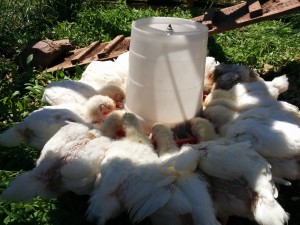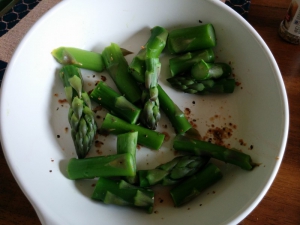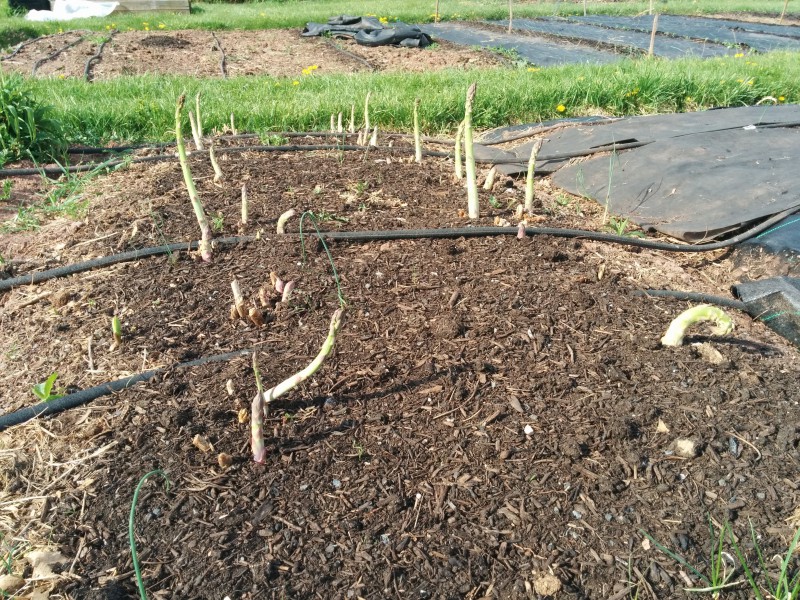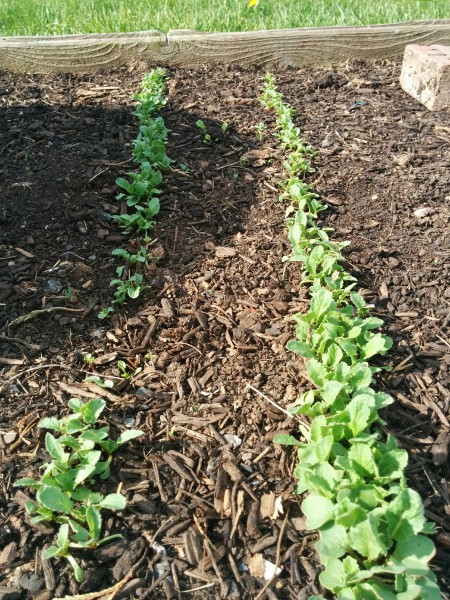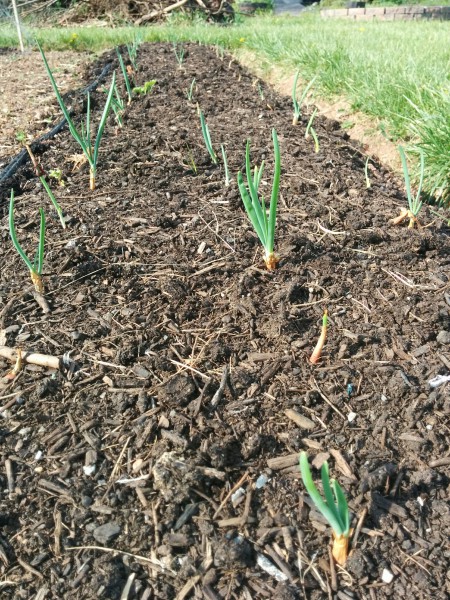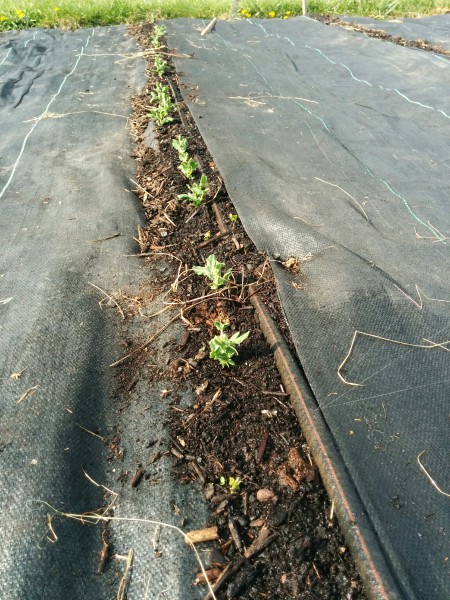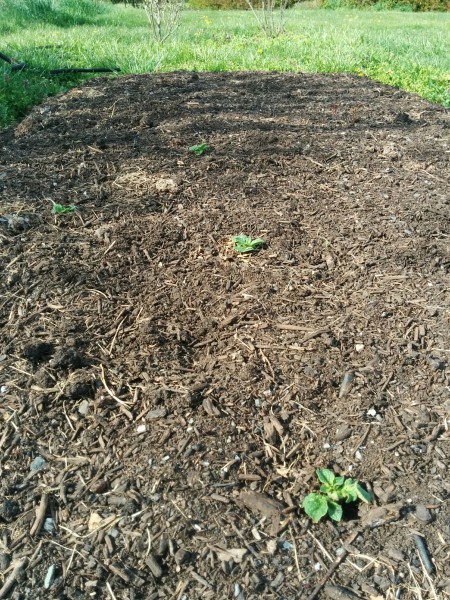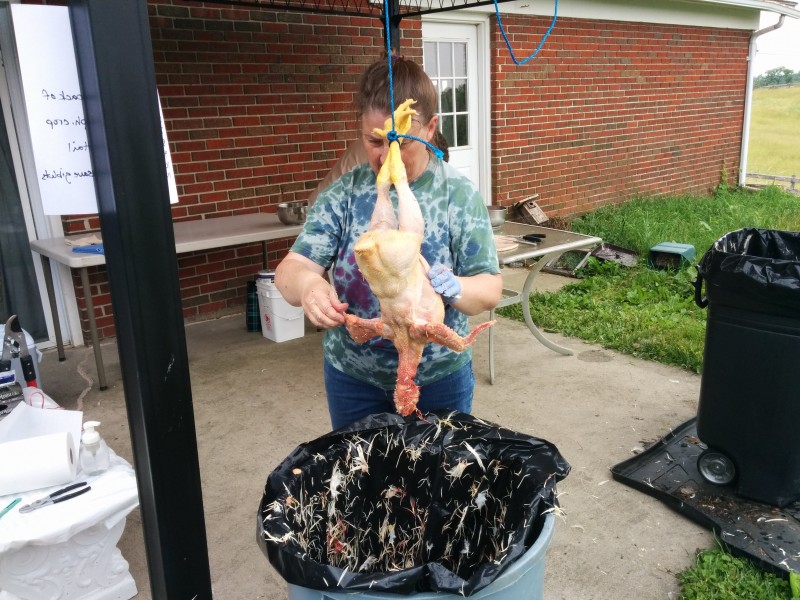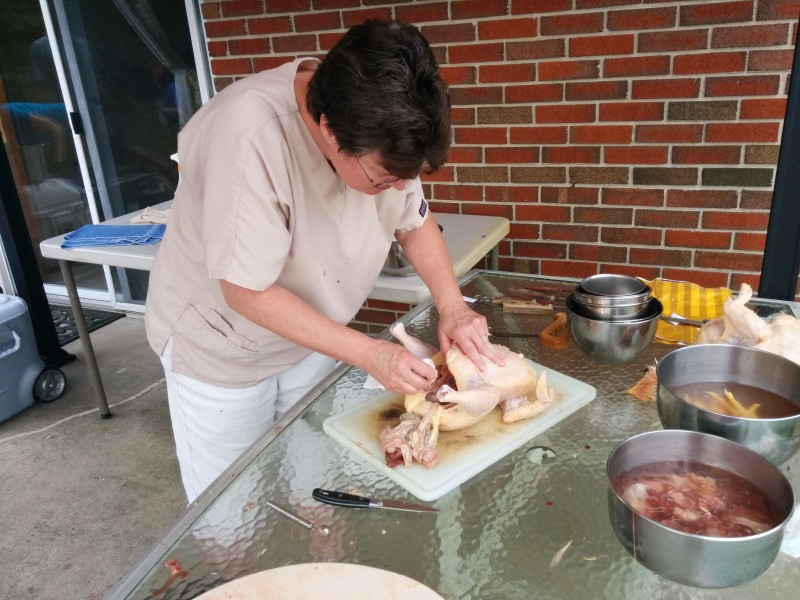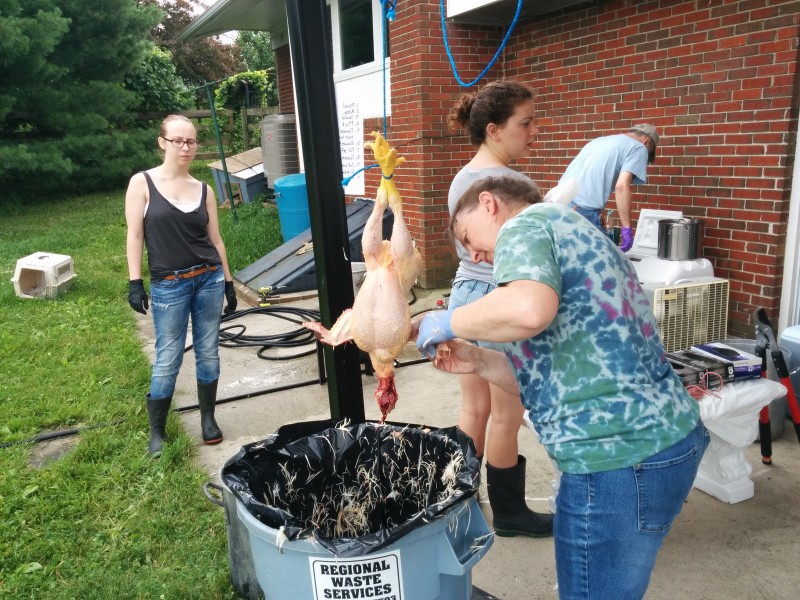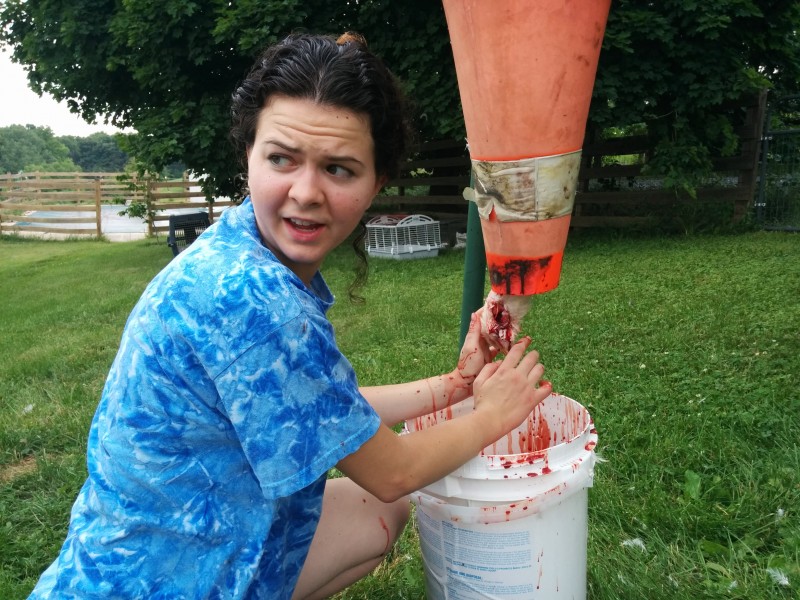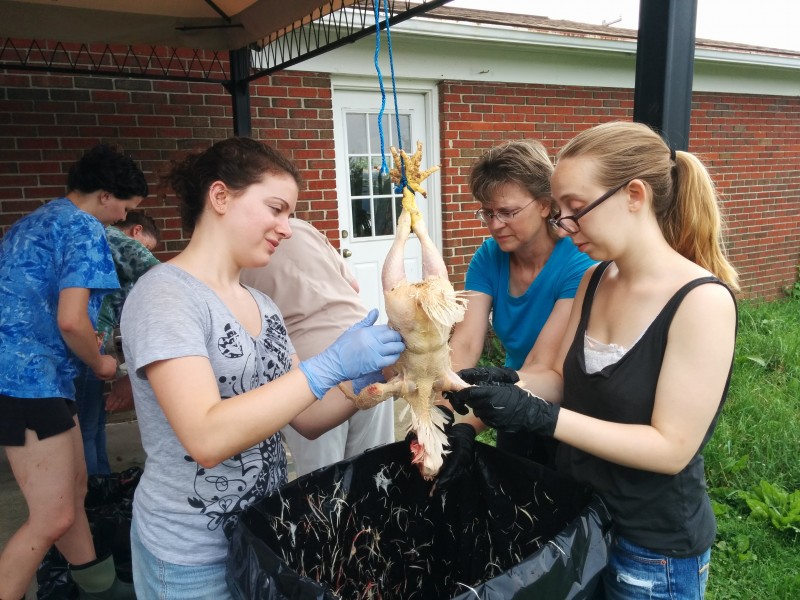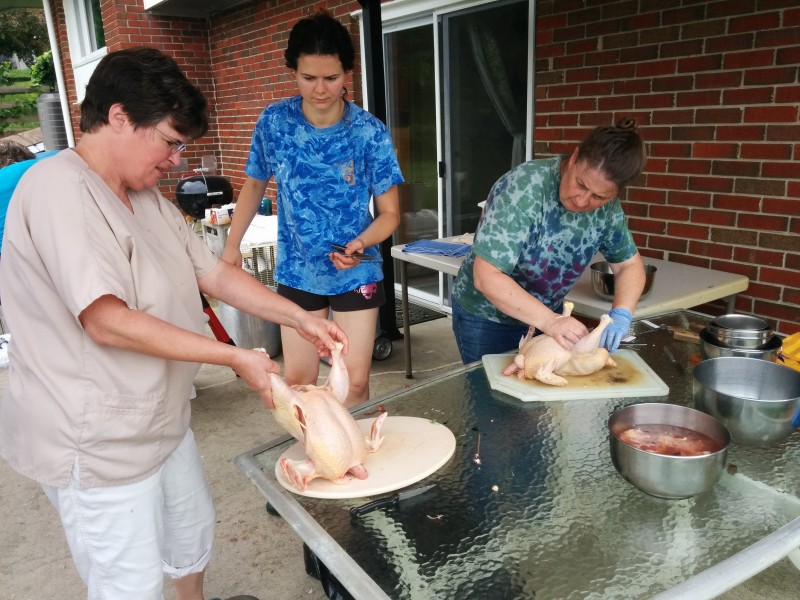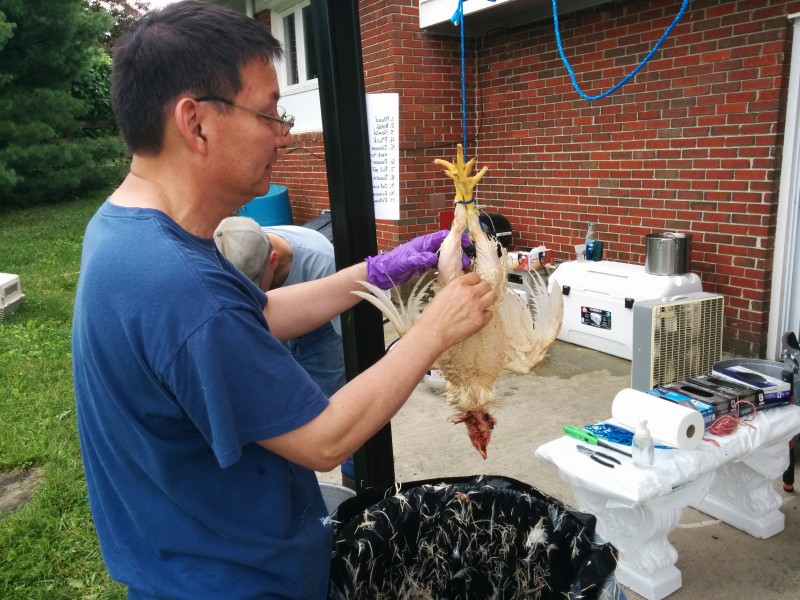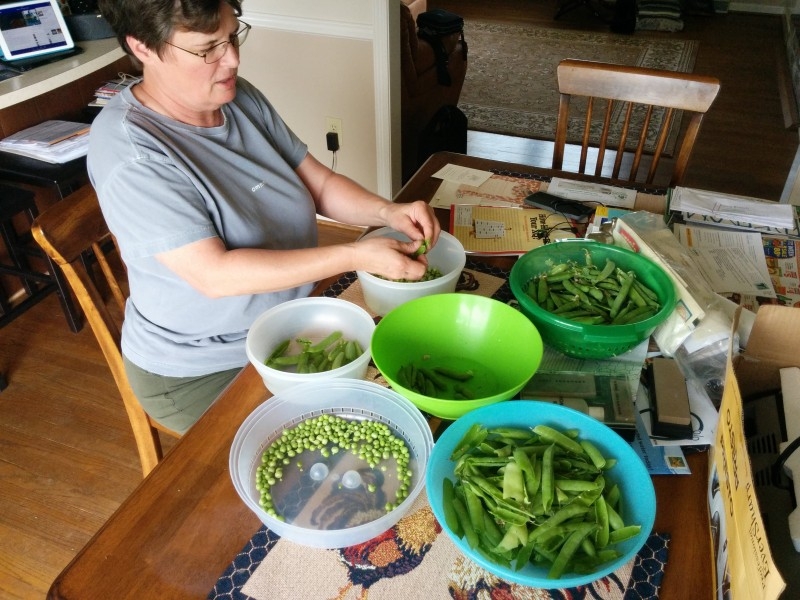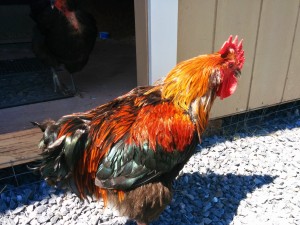todd
Warning: Missing argument 2 for wpdb::prepare(), called in D:\home\littleluceyfarm.com\wwwroot\blog\wp-content\themes\mystique\core\Atom.php on line 2280 and defined in D:\home\littleluceyfarm.com\wwwroot\blog\wp-includes\wp-db.php on line 1210 Warning: Missing argument 2 for wpdb::prepare(), called in D:\home\littleluceyfarm.com\wwwroot\blog\wp-content\themes\mystique\core\Atom.php on line 2280 and defined in D:\home\littleluceyfarm.com\wwwroot\blog\wp-includes\wp-db.php on line 1210 (6 comments, 80 posts)
This user hasn't shared any profile information
Posts by todd

Meat chickens
0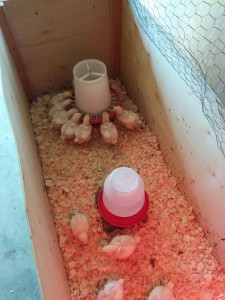 Last year we raised nine meat birds for the first time. In the past we have butchered a few roosters which we got by letting a hen hatch some eggs for us. This is a nice and simple way to increase the laying population, but we also get some roosters that need to be integrated into the flock or eliminated. The take five or six months to reach maturity and tend to be rather lean and tough – which is good in a living bird, but not so good for dinner. So last year we decided to see how real meat birds would be to raise and eat. What a difference! They mature in seven or eight weeks (yes, that’s weeks, not months) and are so fat and juicy and tender. Se we are doing it again this year. We are going from nine to 15 birds this year. They are currently at about three weeks. We never seem to get over how fast they grow and fat they are at such a young age.
Last year we raised nine meat birds for the first time. In the past we have butchered a few roosters which we got by letting a hen hatch some eggs for us. This is a nice and simple way to increase the laying population, but we also get some roosters that need to be integrated into the flock or eliminated. The take five or six months to reach maturity and tend to be rather lean and tough – which is good in a living bird, but not so good for dinner. So last year we decided to see how real meat birds would be to raise and eat. What a difference! They mature in seven or eight weeks (yes, that’s weeks, not months) and are so fat and juicy and tender. Se we are doing it again this year. We are going from nine to 15 birds this year. They are currently at about three weeks. We never seem to get over how fast they grow and fat they are at such a young age.
I still have trouble with raising and killing these animals, but at least it is for food and not sport. That I just can’t imagine. Certainly, some people hunt for sport and eat what they kill. I don’t consider myself any more riteous than anyone else, but I can’t understand how someone can shoot an animal in order to put its head on a wall. End of rant.
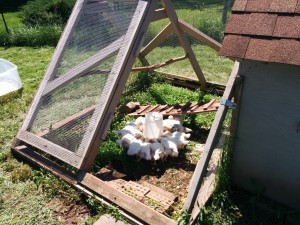 The peeps, if I can still call them that, went outside this morning. The nights are expected to be in the 50s for several days and they are pretty well feathered out, so they should be fine. We spend a half day getting the nursery coop ready for them and they seem happy to have a little more space and some fresh air.
The peeps, if I can still call them that, went outside this morning. The nights are expected to be in the 50s for several days and they are pretty well feathered out, so they should be fine. We spend a half day getting the nursery coop ready for them and they seem happy to have a little more space and some fresh air.
We started feeding them the 24% protein starter food and they finished the bag (40 or 50 lbs), so now they have been switched to the normal starter/grower at 20% and we are letting them run out of food in the evening so they have some time when they are not eating.
We have a processing date at eight weeks, which is a week later than we processed last year. I hope they can still walk by then. These are going to be some very large birds.

April garden update
0April sure is flying by. We had a little bit of cold weather after the garden was started, but then it warmed up again and everything has started to pop up. Unfortunately, the first ten or so shoots of asparagus came up and got bitten by the cold and kind of died back. This is year four and our plants are now very strong and as soon as it warmed up just a bit the second round of shoots came up and we had our first plate of steamed asparagus a couple of lunches ago.
The spinach came up, but it looked like perhaps slugs got to it, because the tender tip were all eaten. I tried to cover the spinach and the radishes the night before the 22 degrees, but the spinach is just gone. The radishes were chewed up a bit, but survived and now are starting to leaf out nicely. The onions look pretty good as do the snap peas, but the regular peas didn’t seem to germinate as well as they should have. They were pretty much planted directly into the new compost I had delivered and maybe that should have been mixed with some other soil. Yesterday I planted two more rows of regular peas which is three and a half weeks after the first planting. Hopefully they will ripen at least a week or two later then the first row.
I worked hard on the slightly raised bed where I planted potatoes last year and decided to plant it with potatoes again this year. It is a perfect spot for them and the ground is great for digging. I added a layer of chicken manure and added several inches of the new compost. About a third of the plants are just popping up and they look nice and healthy. This year I did half Yukon Gold and half some variety of red potato.

Honeybees get their own blog
0Starting last year, I set up a separate blog site for all things related to our bees. There are a few people who also contribute to this group which helps to keep the content moving forward. That site is:
The Honeybee Wranglers.
Check it out.

Starting the garden in 2016
0Once again I am a little late getting the garden started, but after the beautiful weekend, Joni and I made some progress. Garden 1 and garden 2 are ready to plant and the new garen 3 has a nice layer of compost. I will be putting all the viney stuff in garden 3 in mounds. Last year I tried to mix bush beans and some tomatoes and eggplant in with the mounds of squash, zucchini, cantaloupe, and cucumbers and it was way too much. It turned into a jungle. It was quite productive, but unnavigable. This year garden 2 will just have normal rows of whatever and all the vines will tangle in the new space.

Day of homesteading
0Today we processed our nine meat chickens along with 18 more birds from two other families. This isn’t large scale farming, but the largest undertaking of its kind for us. This was the second year for the other families but the first year for us raising meat chickens. These were some generic cross birds we bought at Tractor Supply eight weeks ago. Yeah, Eight weeks! They grow so fast. We have raised several other batches of layers from peeps and they don’t even go outside for eight weeks. And they don’t reach maturity for five or six months. These Cornish Rock crosses grow so fast and have completely different bodies. These are the grocery store chickens that the laying birds are not. We have butchered some roosters at about six months old in the past, and even though they are large and heavy, they just don’t have the meat on them that these birds have.
We had nine people to help with the process and we were quite efficient. We had a killing cone station, a very large cleaning/rinsing tank, one 150 degree dunking tank (dunking between 50 and 60 seconds), two plucking stations and two eviscerating stations. Joni thinks we could have used a third plucking station. We rotated jobs a bit, but Joni did the lion’s share of eviscerating and was very quick about it which was a key to our efficiency and success. The setup was an hour or so and the actual chicken work was only about three hours. Amazing. I was guessing it was going to take most of the day.
We got all the birds in coolers and went inside for a wonderful lunch. Thanks Hawes family. When we got home, I had to rearrange a bunch of beer to make room in the basement refrigerator. We will leave them in the fridge for two or three days and then put them in better bags for freezing. We decided that the Food Saver 11″ bags won’t quite work so we ordered some of the heat shrinking bags that should arrive in the next couple of days. We will also cut up most of the birds for parts, so these could go into the FS bags. The consensus is that a whole chicken is too big for a family of two, so parts is the way to go.
After we had taken care of the chickens for the day, we went out to the garden to pick peas. We got a few snap peas, but mostly picked regular peas. We got a couple of bowls full and shelled them. It’s a lot of work for what seems like a small yield, but we both really love them. They are one of the best vegetables to freeze. They are almost like fresh when thawed.
We spent most of the day working hard for our food. We thought about how this was a way of life many generations ago and were kind of glad we didn’t have to do it every day. But it was a very satisfying day for us.
Roundup is everywhere
0Genetically modified crops are so ubiquitous that Roundup is now likely in the air you breathe and in the water you drink. In a study by the U. S. Geological Survey, 3,732 environmental samples were collected between 2001 and 2010 from 38 states.
Findings
- Glyphosate and, or AMPA were detected commonly in surface waters (59 percent of 470 sites), and infrequently in groundwater or soil water (8.4 percent of 820 sites).
- Glyphosate was detected in more than 50 percent of soil and sediment samples, and water samples from ditches and drains, precipitation, large rivers, and streams.
- Glyphosate was detected in less than 40 percent of water samples from lakes, ponds, wetlands.
- AMPA was detected more frequently than glyphosate in all environmental settings except lakes, ponds, and wetlands.
- AMPA was detected in more than 80 percent of wastewater treatment plant samples; while glyphosate was detected in only about 10 percent of those samples.
- Data from nine surface-water sites sampled repeatedly indicate that glyphosate and AMPA detection frequency, median concentrations, and loads are higher late in the study period (2006-2010) than early (2001-2005).
Bummer, but our reality. As usual, I am not worried for myself, but worried for my grandchildren. I hate to think about all the manmade chemicals that will be building up in their bodies for 100 years.
I used to think how nice it would be to have my little farm and to be able to grow my own organic food. Now I look out my kitchen window and see my garden and beyond that see my neighbor’s 20 acres of GM soybeans and think about my grandkids.

Garden gets started
0The garden got a bit of a late start due to the long cold winter and subsequent wet start to spring. My Grandfather used to always plant onions, lettuce, and peas on St. Patrick’s Day, so every year when that passes me by I feel like I am already behind schedule.
This is the second year since my tiller stopped working and I have gone to the no till system. I like the philosophy of not breaking up the soil and instead adding compost on top. I didn’t buy any compost this year, but instead I have been spreading my own compost made up mostly of chicken poop. I also dump the kitchen scraps, Guinea pig waste and some yard waste. It is pretty rich stuff, but I didn’t turn it enough last year so most of it is still uncomposted. I will have to work on my technique. I have been able to use some on the garden and I hope it is enough. Of course, I also rotate where the various crops will be.
The potatoes in the raised bed did very well last year, but I am moving them to the old strawberry mound along with lots of compost and some straw to lighten up the soil. The potatoes need lots of loose soil. In the raised bed I have planted carrots, radishes and some spinach. I think they will do well.
So far in the main garden area I have planted snap peas, pod peas, lettuce, beets and onions. They all look so good this time of year. I remembered to put up a fence to keep the bunnies from eating the tender top of the peas which they have done in the past.
There is nothing yet in the second area except for the third-year asparagus plants. We have already had one dinner of the asparagus and it is a real treat. We didn’t harvest anything the first two years and I think we now have great plants.

A new year
0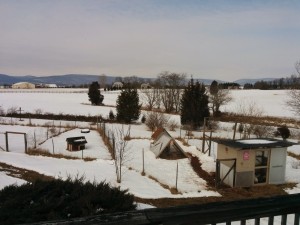 Wow. A whole year has gone by without a post or other update to LLF. Shame on me. I will try to do better this year. The worst part of no updates is that I don’t remember the details of what I planted in the garden and when and what the weather was like and how well the varieties produced. I don’t remember details about the chickens and ducks and my bees.
Wow. A whole year has gone by without a post or other update to LLF. Shame on me. I will try to do better this year. The worst part of no updates is that I don’t remember the details of what I planted in the garden and when and what the weather was like and how well the varieties produced. I don’t remember details about the chickens and ducks and my bees.
I did set up a separate website for a small group of us beekeepers and there was quite a bit of activity on that site. We called ourselves the Honeybee Wranglers and as 2015 progresses we will hopefully build on that information. It has been a long and cold winter just like last year. Maybe not as much snow, but just as long and cold. It is tough for the bees to keep warm and protect the queen and the little bit of brood she may have started producing. So I may not post much about the bees here on the LLF main site, but I will continue to contribute to the Honeybee Wranglers.
In summary, we didn’t do much new with our chickens. We had two chickens die last week. Duran who had some neurological problems in the middle of last year and whom we kept separated from Big Red all fall was found one morning with a very full and hard crop and slumped in the corner of his enclosure. We tended to him in the house for about 24 hours, but he didn’t make it. And then a few days later one of the younger hens was found dead on the floor when we went to open things up in the morning. There was a few other losses over the year. We lost a guinea a few weeks ago – literally lost- as she just disappeared. The guineas can fly out of their yard and perhaps she just got spooked and flew off somewhere and never found her way back. We are down to four now.
We lost a duck to a hawk in early December when we were on a trip to Ohio. Our house sitter called us as we were driving west to give us the news. There were at least two more deaths in the fall. They were only a week or so apart, so I took the second one to the animal health lab for a necropsy and it was determined that she had ILT (Infectious Laryngotracheitis). The state chicken inspector paid us a visit and took cultures (oral swabs) from five birds in each of our three coops. Only the coop where the two chickens died came back positive for ILT, but as a result we were quarantined for two or three months. This means that we take any of our birds off the property during that time. The ban was lifted at the beginning of this year, so we are free to show our championship foul at all the local competitions. Ha ha – not something we do anyway. The virus that causes ILT is a herpes virus and so will be with the birds for life and can be transmitted to other birds. We never saw any of the usual signs of sickness in our flock, but the virus can become life threatening if the birds are ever stressed.

One cold winter
0We are having a very cold winter with quite a bit of snow. It has never been more than 18 inches, but because it is so cold the snow has been persistent. Talk to anyone in Maryland and they will tell you they have had enough winter for this year. We had a brief respite from the cold a few weeks ago amounting to a day or two in the forties and this past weekend we had a couple of days in the 50s. A lot of the snow melted over the weekend, but there is still a ways to go. Now, when it is above freezing, we have puddles and mud. Lots of mud.
Honeybees
I went into the winter with three hives that were pretty strong. A three year hive (#1), a 2013 package hive (#2), and a captured swarm from hive 1 (#3). They each had plenty of honey going into the winter, but by Jan hive #1 looked rather weak. I couldn’t see down inside the boxes very well, but there was just a softball sized cluster up at the top of the top frames. I was thinking that this hive wouldn’t make it through the winter. Hive #2 and #3 looked very strong.
I checked again in late Jan and early Feb and things looked the same. Somehow hive #1 was hanging on. I can’t do much with the hives because of my back surgery in late Jan. I just checked this past Sat, Feb 22 and found hive #2 dead. This is a very discouraging finding. I haven’t torn it apart yet, but don’t see dead bees on the ground. I’ll have to check inside the boxes. I pulled out the frame in the center of the top box and it was completely full of capped honey, so they didn’t starve. This hive had the largest population going into the fall and winter, but I didn’t requeen (like I had originally planned to do) and I suspect that this was a big mistake. I don’t ever want to go into the fall and have the queen make her winter workers from southern stock. Amid the bad news was the surprise good news that hive #1 is still alive. The little softball cluster moves around somewhat, but looks about the same. I added candy to hives #1 and #3. On a really warm day, I should probably check the honey stores in hive #1, but based on the small cluster, I imagine they have plenty of honey.

Goodbye ducks, hello chickens
0Last Saturday we went to a chicken swap. We have done this a couple of times before. This one was small and it was a quick trip, but we were meeting someone there to whom we were selling six of our new call ducks. We needed to bring them in a cage which meant that after handing over the six duck and stashing the $50 in my pocket, we had an empty cage and a burning pocket. Maybe you see where I’m going with this. Naturally we couldn’t drive home with an empty cage, so after looking around for 10 minutes we settled on seven new Bantam Cochins. They are not quite full grown but close. They are about half the size of our other chickens. Cochins have very feathery feet and are rather round little things. We bought five hens and were given two roosters.
One of the hens is actually a Belgian D’Uclle. It is a little taller and thinner and has the prettiest Mille Fleur coloring. All the Cochins are supposedly Mille Fleur colored but a couple of them have yet to develop the classic feather tips. I’m not quite sure if that is a regular color for Cochins or if these are crosses of some kind. The two roosters are not Mille Fleur. One is red/brown and the other gray/blue with a brown neck. Coloring may change some as they mature.
We looked longingly at a batch of little quail, but I guess they will have to wait till next year.
